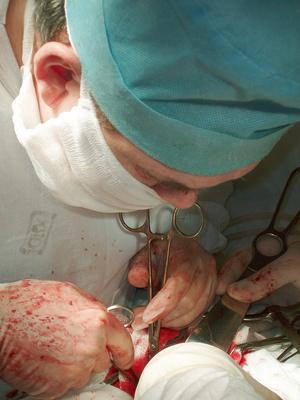A C-section is a surgical procedure used to deliver a baby. Although having a C-section is considered a routine procedure in many hospitals, it is still major abdominal surgery that should be used only when necessary. Knowing how the procedure is done, asking your doctor questions ahead of time, and preparing for the big day can eliminate most fear and anxiety.
Preparation
During preparation, an intravenous catheter is placed in your hand to provide you with all of the fluids and medications you will need during and after the surgery. Your belly will be scrubbed with an antiseptic solution. After it is clean, the nurse may shave the area where the incision will be made. Then, a catheter is placed inside your bladder for the remainder of the surgery.
Medication
Once you are prepped, you are taken to the operating room where anesthesia is given. There are two types of anesthesia: general and local. If you are given general anesthesia, you will not be awake during the surgery. If you are given a local anesthetic, also known as an epidural, you will remain awake during the surgery, but you will be completely numb. In either circumstance, surgical drapes are used to block your view of the actual surgery.
Transverse Incision
Your doctor will most likely make a horizontal incision called a transverse or bikini-cut. This incision is made near the top of the bikini line. It is used when C-sections are planned, if you are within your delivery date, and during repeat C-sections. There is a lower risk of complications from this type of incision, and it is easier to heal after surgery.
Getting to Baby
After the initial incision is made, your doctor will cut through layers of fat, tissue and the uterus. After the uterus has been cut and opened, your doctor will break the amniotic sac the baby has been living in and suction the fluid. After the fluid is gone, he will gently ease your baby’s head out of the incision site and then deliver the body.
Placenta and Sutures
After your baby is delivered, she will be handed to the pediatric nurses. Your doctor will then deliver the placenta and suture your uterus with dissolving stitches. After it is put back into place, he will suture the other layers of tissue and fat. Some doctors prefer using staples instead of sutures. You will have to ask your doctor which method he prefers before having surgery.
Consideration: Vertical Incision
If you are attempting a vaginal delivery that becomes an emergency C-section, or you are planning to deliver a premature baby, your doctor may choose to make the classic C-section incision, which is done as a vertical incision. This is usually a quicker method of delivery, but it involves a higher risk of complications.
After the C-Section
After the doctor has repaired your incision, you are technically done with surgery. You will spend a few days in the hospital to make sure that your incision heals well. Before you leave, the nurses will explain care techniques for your incision site and signs of infection to look for. It is important that you call your doctor immediately if you notice any signs of infection.





